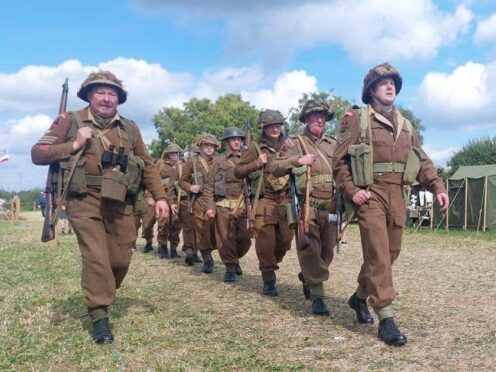
D-Day history groups said their work to inspire remembrance of the Normandy landings is more important now many of the men involved are not here to tell their stories.
The heroism of those who took part in the campaign is preserved around the country by re-enactment societies and living history groups, who want to keep the memories of veterans alive for future generations as the 80th anniversary approaches.
Living history groups collect garments, artefacts and weaponry to display for educational purposes, while reenactment groups go a step further in theatrically recreating the event.
The East Yorkshire Regiment Living Group was set up to accurately portray the actions of the Second Battalion of the East Yorkshire Regiment during the Second World War.

Michael Lycett, the group’s organiser, said the reenactors had become friends with many of the battalion’s veterans over the years.
“We have heard their stories first hand and feel well qualified to pass them on,” he told the PA news agency, adding: “By attending shows and putting on displays we are able to tell their stories to a wide audience.
“This is more important now these men are not here to do so themselves.”
Mr Lycett said it is imperative that the world remembers the personal heroism and sacrifice shown by conscripted civilians.
“They were pulled away from their families and friends and trained to be soldiers, to kill,” he said.

“This wasn’t something they wanted but they felt they had to do their bit.”
Mr Lycett said the popularity of living history had increased since he joined the group 30 years ago, largely thanks to support from English Heritage and military shows.
New re-enactment groups are still being founded, such as the 3rd Parachute Brigade & Home Front (British 6th Airborne) which was set up in 2017.
The group displays weapons and explosives, as well as a pot of sand from each of the landing beaches and a lump of concrete from the Merville Gun Battery in Normandy.

When the weather permits, the group unveils a parachute which inflates in the breeze.
Andy Wilkinson, a member of the group, said: “Living history and static displays are important if for no other reason than it allows people to have a chance to hold things that are normally in books, films or museums, and that can bring things into reality.”
Mr Wilkinson has made a blackboard with a map of the 6th Airborne’s drop zone and landing zone on D-Day to better explain the division’s successes in June 1944.
“I am saddened that there is never much shown in film about what the British forces achieved,” he said.
“British 6th Airborne (1 Division) achieved all of its objectives while the US 101st & 82nd Airborne (2 Divisions) failed, yet it’s always the Americans that are shown doing well.”

The D-Day groups put on displays at events such as the Suffolk Military Show, which portrays historical conflicts from the past 1,000 years. This year’s event will take place on July 27 and 28.
Glenn Caton, 61, who runs the event in Trinity Park, Ipswich, with his family, said re-enactment and living history groups are vital for stoking remembrance.
“Unfortunately events such as the D-Day landings are now becoming confined to the history books, as these significant moments are largely beyond living memory,” he said.
“A professionally-run re-enactment and living history event enables both young and old to immerse themselves in an interactive experience.
“One of the mantras The Suffolk Military Shows has adopted is ‘I hear I forget, I see I remember, I do I understand’, and that’s exactly what the show provides over the two days it is held.”

Enjoy the convenience of having The Sunday Post delivered as a digital ePaper straight to your smartphone, tablet or computer.
Subscribe for only £5.49 a month and enjoy all the benefits of the printed paper as a digital replica.
Subscribe